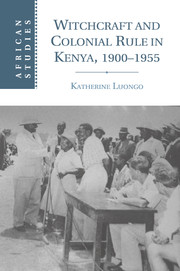Book contents
- Frontmatter
- Contents
- Photographs
- Acknowledgments
- 1 Introduction
- 2 Clans and Councils, Caravans and Conquest, Cosmology and Colonialism
- 3 Understanding Uoi, Uwe, and Kithitu in Ukambani
- 4 The “Cosmology” of the Colonial State
- 5 The Wakamba Witch Trials
- 6 Witchcraft, Murder, and Death Sentences after Rex v. Kumwaka
- 7 The World of Oathing and Witchcraft in Mau Mau–era Machakos
- 8 Cleansing Ukambani Witches
- 9 Epilogue
- Glossary
- Bibliography
- Index
- References
1 - Introduction
Published online by Cambridge University Press: 07 October 2011
- Frontmatter
- Contents
- Photographs
- Acknowledgments
- 1 Introduction
- 2 Clans and Councils, Caravans and Conquest, Cosmology and Colonialism
- 3 Understanding Uoi, Uwe, and Kithitu in Ukambani
- 4 The “Cosmology” of the Colonial State
- 5 The Wakamba Witch Trials
- 6 Witchcraft, Murder, and Death Sentences after Rex v. Kumwaka
- 7 The World of Oathing and Witchcraft in Mau Mau–era Machakos
- 8 Cleansing Ukambani Witches
- 9 Epilogue
- Glossary
- Bibliography
- Index
- References
Summary
“Fictive Narratives” in Colonial East Africa
Before embarking on her well-known series of autobiographical novels, the white Kenyan writer Elspeth Huxley was the author of a cycle of crime novels set in Chania, a fictional East African colony modeled on interwar-era Kenya. In her 1937 mystery, Murder at Government House, the plot of which centered on the strangling of Chania’s governor, Huxley included a lengthy, elaborate anecdote about another high-profile murder case in the colony, the “Wabenda witchcraft case.” Chania’s secretary for Native Affairs recounted the local narrative of the “Wabenda witchcraft case” to the detective in charge of investigating the governor’s murder:
The Wabenda, among whom witchcraft was more strongly entrenched than among most Chania tribes, had put to death an old woman, who, they alleged, was a witch. The woman had stood trial before the elders and the chiefs of the tribe, had been subjected to a poison ordeal, and found guilty of causing the death of one of the head chief’s wives and the deformity of two of his children. Then, following the custom of the tribe, she had been executed, in a slow and painful manner…. It was a horrible death, but meted out after due trial, and for the most anti-social crime in the Wabenda calendar.
After outlining the circumstances surrounding the witch-killing, the secretary for Native Affairs turned to how Wabenda and British conceptions and processes of justice collided in the context of the case. He elaborated,
The chiefs and elders were put on trial for the murder of the old witch. Forty-five of them appeared in the dock – a special dock built for the occasion. They did not deny that the witch had died under their instructions. They claimed that in ordering her death they were protecting the tribe from sorcery, in accordance with their obligations and traditions. They were found guilty and condemned to death. There was no alternative under British law; the judges who pronounced sentence did so with reluctance and disquiet.
But as the secretary for Native Affairs noted, the “Wabenda witchcraft case” was not easily resolved by the sentencing of the forty-five Wabenda in the British courts. He noted,
The Government was in an awkward position. It could not, obviously, execute forty-five respectable old men, many of them appointed to authority and trusted by the Government, who had acted in good faith and according to the customs of their fathers. In the end it had compromised. Thirty-four of the elders had been reprieved and pardoned. Ten had been reprieved and sentenced to terms of imprisonment. In one case, that of the senior chief who had supervised the execution, the death sentence had been allowed to stand.
Finally, the secretary for Native Affairs addressed some of the ways in which the case was figured in additional “judicial settings” in the Supreme Court of Chania, in the governor’s Privy Council, and in the equally salient “courts of opinion” of various metropolitan and Chanian publics. He explained,
The case was not yet over. The sentenced chief, M’bola, had appealed to the Supreme Court, lost, and finally appealed to the Privy Council. Feeling in native areas ran high. Agitators had seized upon the case as an example of the tyranny and brutality of British rule. Administrators feared serious troubles should it be carried out.
The detective to whom the story of the case had been addressed nodded in assent to the secretary’s explanations, noting that the events were “familiar” to him as well as to “every European in the colony.”
- Type
- Chapter
- Information
- Witchcraft and Colonial Rule in Kenya, 1900–1955 , pp. 1 - 28Publisher: Cambridge University PressPrint publication year: 2011

